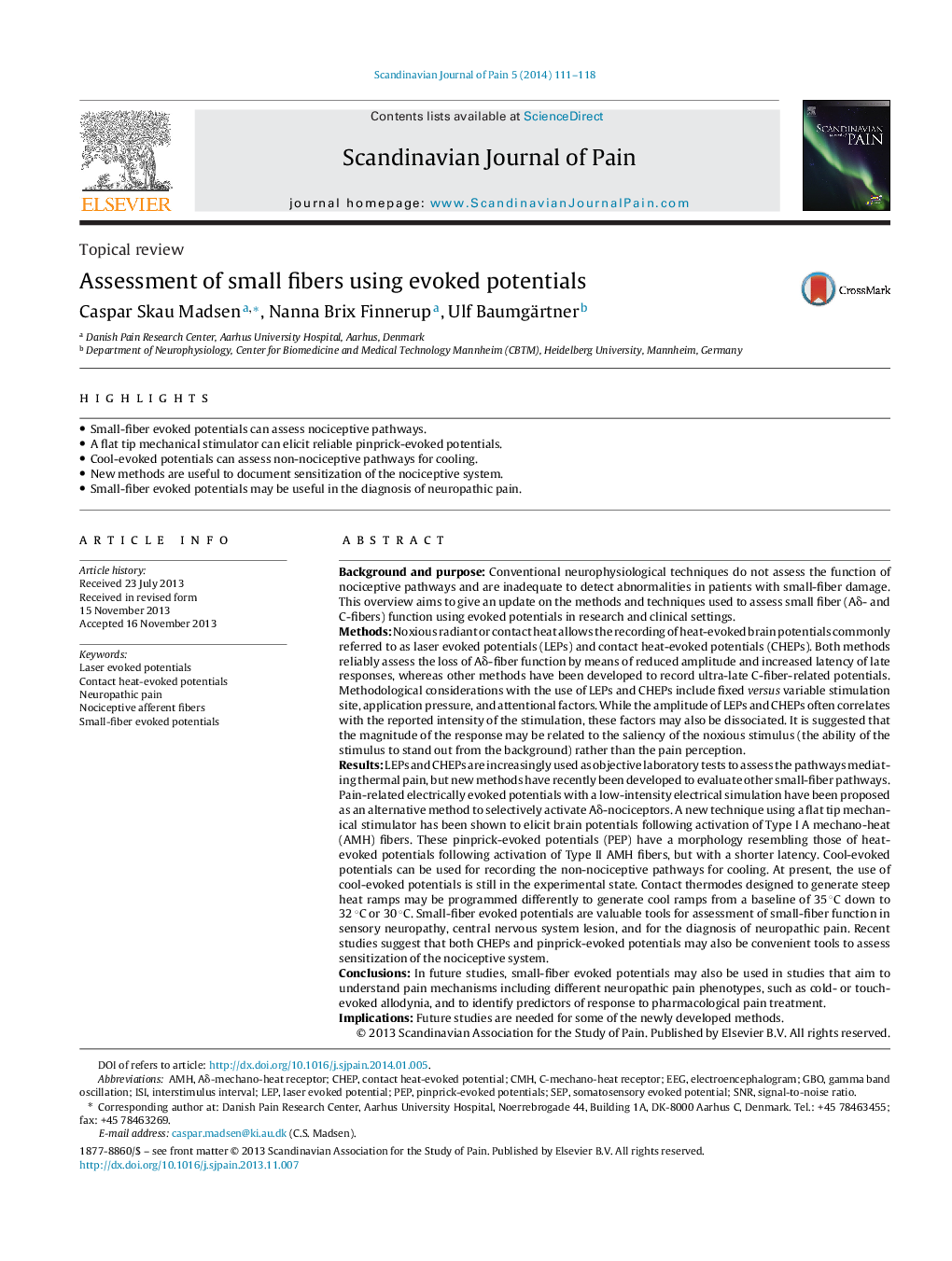| کد مقاله | کد نشریه | سال انتشار | مقاله انگلیسی | نسخه تمام متن |
|---|---|---|---|---|
| 2770767 | 1567817 | 2014 | 8 صفحه PDF | دانلود رایگان |
• Small-fiber evoked potentials can assess nociceptive pathways.
• A flat tip mechanical stimulator can elicit reliable pinprick-evoked potentials.
• Cool-evoked potentials can assess non-nociceptive pathways for cooling.
• New methods are useful to document sensitization of the nociceptive system.
• Small-fiber evoked potentials may be useful in the diagnosis of neuropathic pain.
Background and purposeConventional neurophysiological techniques do not assess the function of nociceptive pathways and are inadequate to detect abnormalities in patients with small-fiber damage. This overview aims to give an update on the methods and techniques used to assess small fiber (Aδ- and C-fibers) function using evoked potentials in research and clinical settings.MethodsNoxious radiant or contact heat allows the recording of heat-evoked brain potentials commonly referred to as laser evoked potentials (LEPs) and contact heat-evoked potentials (CHEPs). Both methods reliably assess the loss of Aδ-fiber function by means of reduced amplitude and increased latency of late responses, whereas other methods have been developed to record ultra-late C-fiber-related potentials. Methodological considerations with the use of LEPs and CHEPs include fixed versus variable stimulation site, application pressure, and attentional factors. While the amplitude of LEPs and CHEPs often correlates with the reported intensity of the stimulation, these factors may also be dissociated. It is suggested that the magnitude of the response may be related to the saliency of the noxious stimulus (the ability of the stimulus to stand out from the background) rather than the pain perception.ResultsLEPs and CHEPs are increasingly used as objective laboratory tests to assess the pathways mediating thermal pain, but new methods have recently been developed to evaluate other small-fiber pathways. Pain-related electrically evoked potentials with a low-intensity electrical simulation have been proposed as an alternative method to selectively activate Aδ-nociceptors. A new technique using a flat tip mechanical stimulator has been shown to elicit brain potentials following activation of Type I A mechano-heat (AMH) fibers. These pinprick-evoked potentials (PEP) have a morphology resembling those of heat-evoked potentials following activation of Type II AMH fibers, but with a shorter latency. Cool-evoked potentials can be used for recording the non-nociceptive pathways for cooling. At present, the use of cool-evoked potentials is still in the experimental state. Contact thermodes designed to generate steep heat ramps may be programmed differently to generate cool ramps from a baseline of 35 °C down to 32 °C or 30 °C. Small-fiber evoked potentials are valuable tools for assessment of small-fiber function in sensory neuropathy, central nervous system lesion, and for the diagnosis of neuropathic pain. Recent studies suggest that both CHEPs and pinprick-evoked potentials may also be convenient tools to assess sensitization of the nociceptive system.ConclusionsIn future studies, small-fiber evoked potentials may also be used in studies that aim to understand pain mechanisms including different neuropathic pain phenotypes, such as cold- or touch-evoked allodynia, and to identify predictors of response to pharmacological pain treatment.ImplicationsFuture studies are needed for some of the newly developed methods.
Journal: Scandinavian Journal of Pain - Volume 5, Issue 2, April 2014, Pages 111–118
